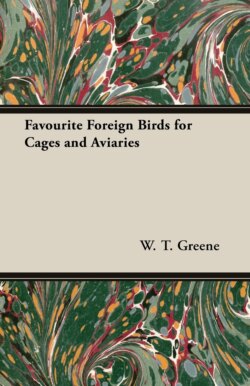Читать книгу Favourite Foreign Birds for Cages and Aviaries - W. T. Greene - Страница 8
На сайте Литреса книга снята с продажи.
ОглавлениеFAVOURITE FOREIGN BIRDS.
CHAPTER I.
INTRODUCTION.
Popularity of Aviculture—Native and Exotic Races Compared—Classification—Scientific Names.
AVICULTURE, long since carried to perfection in France and Germany, is yet in its infancy in Great Britain, though vastly more people are interesting themselves about birds at the present day than used to be the case a dozen years ago, when very few amateurs had any knowledge of the beautiful and attractive feathered denizens of foreign lands, many of which are now being naturalised in our midst, and have become almost as abundant as our own canaries or sparrows.
At first sight this no doubt appears extraordinary, especially when we contrast our own bleak and changeable climate with that enjoyed by the fertile and fragrant lands of which most of the foreign birds we meet with over here are natives. What a contrast, for instance, between the orange groves of Florida, or the palm-covered slopes of Western Africa, and our own country, where vegetation is dormant for half the year, and the trees are so many leafless skeletons from November to March or April! What a contrast, too, between the warmth of the same regions and the cold, damp, and fog of our native isles! So great, indeed, that one is compelled to wonder how birds indigenous to the former can ever be sufficiently acclimatised to live, and even to thrive, in the latter. Yet such is the case, and in the following pages I propose passing in review some of the different species of exotic birds which I have found adapt themselves most readily to their new surroundings in confinement.
The passion for bird-keeping—which, by the way, is steadily on the increase among us—usually has its origin in very humble beginnings; but it rapidly gains strength, and before long experiments are made and investments ventured on that, without preparation, would at one time have filled the soul of the adventurous aviarist with apprehension and awe.
Some writer has called the birds “the fairest of all God’s creatures,” and I think he is not far wrong. But, much as I admire our own native races, I must confess to a preference for the birds that are brought to us from foreign parts. True, the latter have not, as a rule, such musical talents as our own; but, from whatever cause, they adapt themselves much more readily to a life in confinement, in which they never, unless out of health, wear that look of sullen discontent that is characteristic of so many English cage-birds. Then also, as a rule, the foreign species are much more conspicuous for brilliancy of colouring, and even for elegance of form, than the birds that adorn our fields and hedgerows, or hide themselves as much as possible from human observation in our woods and plantations. So, without entirely deprecating the keeping of native birds in confinement, I am decidedly of opinion that the acclimatisation of foreign species will be, on the whole, a greater source of gratification to the aviarist; and in the end he will also find that his hobby will cost him less than if he “went in” for keeping a collection of our British birds.
A word more, before I close these introductory remarks, as to the system, or rather want of system, that will necessarily characterise these pages. Scientific classification is out of the question where only a selection of species is reviewed; therefore I have determined to take the various groups in alphabetical order—which will, perhaps, be as convenient a method for those who may read these pages as any that I could adopt.
The scientific names given are in nearly all cases those used by the Zoological Society of London in their list of vertebrated animals, although I do not in every instance agree with its absolute correctness, and, in the matter of classification, differ with the Society in many instances.
As prices vary so much according to circumstances, it has not been thought desirable to quote any in the following pages.
